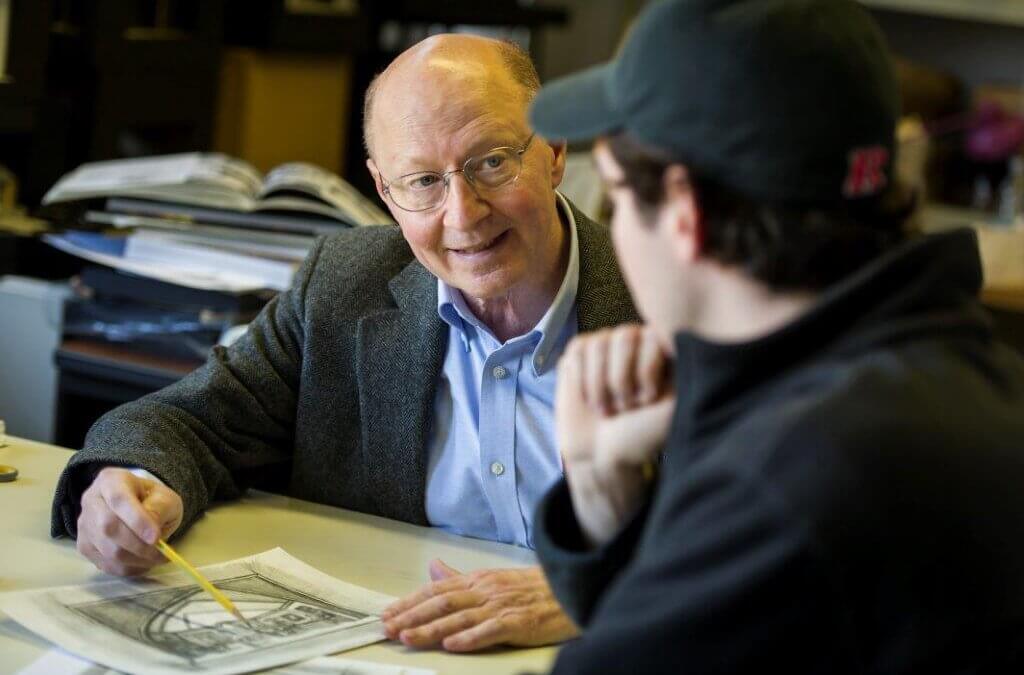
R. Michael Miller, former head of scenic design in the Theater Department who taught at Rutgers for nearly three decades until his retirement in 2019, died February 2, 2024, at age 70.
Miller’s work was seen on Broadway (Souvenir, Eminent Domain, The Boys in Autumn), off-Broadway, and at storied regional venues across the country including the Guthrie Theater, American Conservatory Theater, Berkshire Theatre Festival, and the Oregon Shakespeare Festival, among many others. He was an assistant art director on the feature films Falling in Love, Shadows and Fog, and Bullets Over Broadway, and he assisted on several productions for American Ballet Theatre and the Metropolitan Opera House.
But in the classroom, he was best known for his dedication to teaching and love for storytelling.
“Sometimes, we would casually talk about a play, like Who’s Afraid of Virginia Wolf, and our discussion of character or concept would bring tears to his eyes,” remembers Gennie Neuman Lambert MFA ’12. “Then, he would stop, acknowledge the importance of the work, and get back to that ground plan or sketch.”
Through education in classic skills like hand drafting and integrating architectural history into a work, Miller taught design “almost like a language,” says Lambert, “an art that helped you learn how to think in a fluid and confident way.”
“He taught you how to solve problems in a way that elevated your storytelling sensibilities and expression,” says Lambert, a scenic designer and assistant professor of theater at Kent State University. “Artistically, he let you be yourself but always pushed us to create complete ideas to bring out the best in our directors and collaborators.”
Miller helped countless theater students realize their visions for on-campus performances as they worked toward their degrees.
Alum Michole Biancosino had the opportunity to work with Miller on a production of Maria Irene Fornés’s Mud, which she directed at Levin Theater as a thesis project to earn her MFA in directing in 2006.
Miller and Biancosino met for months to discuss the play before laying a groundwork of ideas about the set, lighting, and costumes. Miller encouraged Biancosino and the student designers to explore the play from all angles: reading articles and books and sharing in-depth research collected over weeks of study.
“It was the best process I’ve had to date, and I use it as a model each time I embark on a new piece with designers,” says Biancosino, the co-founding artistic director of Project Y Theatre Company in New York City who has also taught courses at Rutgers. “He taught me how I wanted to work.”
Miller’s dedication to teaching was so strong that he used a phrase—“the Rutgers Guarantee”—to describe the support he offered to students throughout their careers, says Ellen Bredehoft, chair of the Theater Department and head of costume technology.
Miller emphasized that, as a teacher, “we are always there for the students, even after they walk at graduation and receive their degree,” says Bredehoft. “We’re all a part of the Rutgers Theater family.”
Bredehoft says her mentor, colleague, and friend will be remembered by his students for “the stoop project” in drafting class, in which Miller had students construct a 3D model replica of a Brooklyn stoop, as well as his New York City architecture walking tours and his expression of being “satisfactory or better.”
“Michael was the best of all of us,” Bredehoft says. “He was compassionate, funny, and supportive of every student, staff, and faculty member. He was the gentle giant who constantly challenged us to be the best version of ourselves.”
Miller worked on theatrical scenes as far away as Tokyo, where he designed The Miracle Worker, directed by Terry Schreiber, but he maintained a decades-long relationship with New Brunswick’s own George Street Playhouse, where he designed more than 20 sets.
Christopher Bailey, George Street’s production manager and a lighting and sound designer who worked with Miller on 17 productions, says Miller was a master of his craft and “a perfectionist in every way,” from sketching to building models to creating drafts.
This meticulous work ethic led to “a beautiful canvas” that was a joy for other designers to work on, says Bailey.
“His designs were flawless and astonishing to look at,” Bailey remembers. “They told a story, gave a history, and emotionally lifted the production. He would not let you get away with shortcuts when building his shows, and you always understood why after you stepped back and took in his work.”
Perhaps even more legendary than Miller’s designs—which were featured in Setting the Stage: The Art of Theatrical Design, an exhibition in 2007 at SUNY Brockport—was his sense of humor.
Biancosino recalls that Miller collected toys and would bring them to class on occasion as a sort of stress reliever in what could be an intense environment. He had a “sense of joy and mirth, which was palpable and contagious,” Biancosino says.
“Although he was serious about the work and held high standards for all of us, he also was a great one on a break to just goof around,” Biancosino continues. “He loved to laugh and he loved theater and play. I will never forget how he’d light up when responding to students’ ideas in the room—he was curious and he [gave] us an opportunity to take part in a path of creativity and curiosity.”
For Lambert, Miller’s generosity and helpful nature, along with his fun-loving attitude, are qualities she strives to bring to her own work.
“I’m sure I’m not the only MGSA alum who puts little toys and monsters in scale models to make the carpenters smile,” says Lambert. “I think those big-picture theater-artist values and those small traditions will keep going in his students.”
Story by Risa Barisch. Photo by Matt Rainey.

